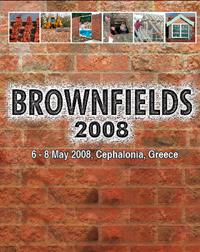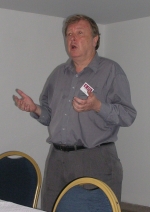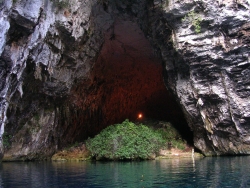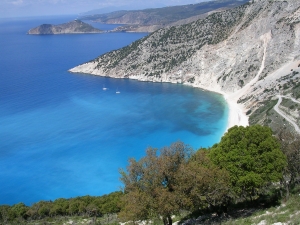Fourth International Conference on Prevention, Assessment, Rehabilitation, Restoration and Development of Brownfield Sites
Cephalonia, Greece
Overview
 The Fourth International Conference on Prevention, Assessment, Rehabilitation and Development of Brownfield Sites, Brownfields 08, took place recently on the island of Cephalonia in Greece, organised by the Wessex Institute of Technology (WIT) and the University of Thessaly, and sponsored by the International Journal of Sustainable Planning and Development.
The Fourth International Conference on Prevention, Assessment, Rehabilitation and Development of Brownfield Sites, Brownfields 08, took place recently on the island of Cephalonia in Greece, organised by the Wessex Institute of Technology (WIT) and the University of Thessaly, and sponsored by the International Journal of Sustainable Planning and Development. The conference follows the success of the first three conferences in the Series, held in Cadiz in 2002, Siena in 2004 and in Tallinn in 2006. The meeting provided an international forum to discuss the problems facing the public andTiedemann private sectors and the engineering and scientific communities related to brownfields reuse for securing sustainable development. Given the economic and social benefits of brownfields redevelopment, there is a need for guidance on the process providing information on required risk assessment, remediation technologies, involvement of various stakeholders and community and public acceptability. The preparation of the guidelines requires further research, as well as the sharing of information, lessons and experience among experts in this field through conferences such as Brownfields 08.
Opening Address
The meeting was opened by Professor Viktor Popov, Head of Environmental Fluid Mechanics Division at WIT and Elias Beriatos, Professor of Spatial Planning and Geography at the University of Thessaly, who welcomed the Delegates and wished them productive participation in the Conference. Viktor passed on a message to the delegates from Professor Carlos Brebbia, the Director of Wessex Institute of Technology, who could not attend this year’s meeting due to minor injury of his foot. He explained the commitment of the Institute to knowledge transfer activities, particularly those involving inter-disciplinary fields such as Brownfields.Viktor explained that the Institute has recently developed excellent residential facilities which will allow for greater expansion of its activities, particularly relevant to its links with many institutions all over the world. The growth has already resulted in an increase in the number of researchers in the four Research Divisions at WIT.
Further developments have occurred in the publishing activities of WIT Press, the associate arm of the Institute, which is now becoming more digitally oriented. This will result in the publications of WIT being more readily available. The most successful of these activities has been the eLibrary, containing the papers presented at WIT conferences, which is consulted by an ever increasing number of researchers.
Viktor concluded his opening remarks by stressing WIT’s commitment to international partnerships and joint research projects. He hoped that the participants would consider visiting the Institute (WIT Campus) in the near future to discuss possible ways of working together.
Conference Sesssions
 The papers presented at the conference covered a wide range of topics, grouped in the following sections:
The papers presented at the conference covered a wide range of topics, grouped in the following sections: - Rehabilitation of Brownfields
- Development Issues
- Remediation Studies and Technologies
- Case Studies
- Risk Assessment and Management
- Community and public involvement
Special Papers
There was a series of special papers presented by well-known colleagues:
- Integrating sustainable development and brownfields reuse – principles and practice, C. N. Brooks, GETG, USA
- Derelict building installations and infrastructures in Greek Spa Towns: the case of Kamena Vourla and Ypati, E. Beriatos presented by M. Papageorgiou, University of Thessaly, Greece
- Revitalizing secondary market Brownfield sites, A.Bogen, Down to Earth Consulting, USA
- Bridging mining theory with soil remediation, D. Kaliampakos presented by T. Karachaliou, NTUA, Greece
- Brownfield identification: different approaches for analysing data detected by means of remote sensing, V. Ferrara, Sapienza University of Rome, Italy
- World Heritage Inscription for naval heritage brownfields? C. Clark, Consultant, UK
- Application of the “ARA-CoSSSLs” risk analysis approach at a sub-area of a relevant Italian contaminated site, F. Tatàno, University of Urbino, Italy
Technical Excursion
The technical excursion included the famous Katavothres (shallow holes) near the entrance to Argostoli’s natural harbour. A tracer experiment has shown that the water travels 15 kilometres upground through rifts in the limestone before appearing at springs at the other side of the island. The other places visited were the beautiful Myrtos Bay, the underground Melissani Lake which is partially open due to collapse of part of the ceiling, and the village of Aghia Efimia, where part of the water from Katavothres appears.


Conference Banquet
The conference banquet took place at the Mediteranee Hotel, where the meeting was held. The evening was delightful and helped to stress the links among the participants at Brownfields 08.
Publication of Papers
The proceedings of Brownfields IV, 288pp (ISBN: 978-1-84564-105-4) are available in hardback from WIT Press priced at £95.00/US$190.00. Orders can be placed by telephone: +44 (0) 238 029 3223, fax: +44 (0) 238 029 2853, email This email address is being protected from spambots. You need JavaScript enabled to view it. or via the WIT Press website at: www.witpress.com.Papers from the conference will also be hosted online in the WIT eLibrary as voume 107 of WIT Transactions on Ecology and the Environment (ISSN: 1743-3541). For more details visit the WIT eLibrary at: library.witpress.com

 Wessex Institute
Wessex Institute